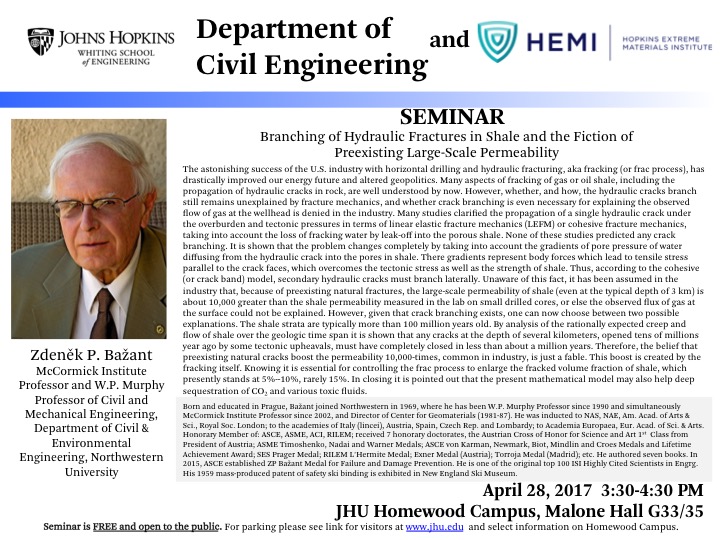April 28, 2017 @ 3:30 pm - 4:30 pm
Event Navigation
Branching of Hydraulic Fractures in Shale and the Fiction of
Preexisting Large-Scale Permeability
Dr. Zdeněk P. Bažant, Northwestern University
The astonishing success of the U.S. industry with horizontal drilling and hydraulic fracturing, aka fracking (or frac process), has drastically improved our energy future and altered geopolitics. Many aspects of fracking of gas or oil shale, including the propagation of hydraulic cracks in rock, are well understood by now. However, whether, and how, the hydraulic cracks branch still remains unexplained by fracture mechanics, and whether crack branching is even necessary for explaining the observed flow of gas at the wellhead is denied in the industry. Many studies clarified the propagation of a single hydraulic crack under the overburden and tectonic pressures in terms of linear elastic fracture mechanics (LEFM) or cohesive fracture mechanics, taking into account the loss of fracking water by leak-off into the porous shale. None of these studies predicted any crack branching. It is shown that the problem changes completely by taking into account the gradients of pore pressure of water diffusing from the hydraulic crack into the pores in shale. There gradients represent body forces which lead to tensile stress parallel to the crack faces, which overcomes the tectonic stress as well as the strength of shale. Thus, according to the cohesive (or crack band) model, secondary hydraulic cracks must branch laterally. Unaware of this fact, it has been assumed in the industry that, because of preexisting natural fractures, the large-scale permeability of shale (even at the typical depth of 3 km) is about 10,000 greater than the shale permeability measured in the lab on small drilled cores, or else the observed flux of gas at the surface could not be explained. However, given that crack branching exists, one can now choose between two possible explanations. The shale strata are typically more than 100 million years old. By analysis of the rationally expected creep and flow of shale over the geologic time span it is shown that any cracks at the depth of several kilometers, opened tens of millions year ago by some tectonic upheavals, must have completely closed in less than about a million years. Therefore, the belief that preexisting natural cracks boost the permeability 10,000-times, common in industry, is just a fable. This boost is created by the fracking itself. Knowing it is essential for controlling the frac process to enlarge the fracked volume fraction of shale, which presently stands at 5%–10%, rarely 15%. In closing it is pointed out that the present mathematical model may also help deep sequestration of CO2 and various toxic fluids.
Seminar will be held in Malone Hall G33/35.





